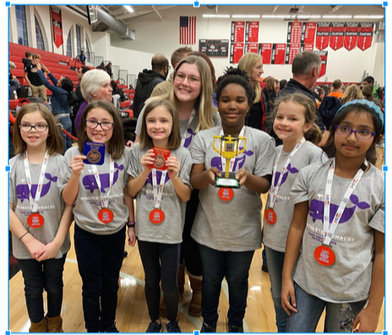|
Starting an FLL team can be intimidating, especially as a student. My name is Anna Nesbitt. I’m a member of Girls of Steel FRC 3504, and currently serve as the Outreach Lead, as well as a programmer, on the team. I was a part of my elementary school’s FLL team in middle school, and found my love for robotics there. Since eighth grade, I’ve started two FLL Jr. teams and one FLL team, as well as mentored at an FLL Skills Camp hosted by Girls of Steel. Starting these teams has been an incredibly rewarding experience, and I’m here to tell you how you can do it yourself! First things first, you have to get your ideas down. Ask yourself: What age group will I be mentoring? Will this team be co-ed or all girls? How many students will be on this team? Where will I run this team? Are there already FIRST programs in place where I want to start this team? For me, I started an all-girls FLL Jr. team at an elementary school, and used the same group of girls for the FLL team that I founded a year later. This not only makes it easier on you, but also lays down the foundation for a comprehensive pipeline of STEM programs if you provide opportunities for kids every year along the way. Next, you need to identify your point person. For me, this was an after school programs coordinator, but it can also be a STEM teacher or a teacher of the grade that you are looking to mentor. Remember, they should be someone you know and trust- FLL won’t send you emails about the team, so it’ll be up to them to forward all communications to you. Once you have identified who you would like this person to be, set up a meeting with them. Remember, you are the expert on FIRST- for all you know, your point person may not have ever heard of FIRST before. Talk from your heart, and really focus on the impact that FIRST has had on you and the people you know. Another thing to stress to them is why you are the most qualified person to run this team. This part was hard for me; I was a 14 year old freshman- why would anyone want to spend a decent amount of money on something that would be completely run by a person so young? I focused on expressing my experience and connection to the girls. As a young woman in STEM, I could provide them with insight on what they are to expect along the way as they move up in STEM, as well as be there for them in social situations where they may not want to go to an older teacher. Another hurdle to expect is the big question of exclusion. This comes up when you’re trying to start an all girls team. “Doesn’t this set boys back in STEM?” “This is a co-ed school with co-ed programs, and we don’t want to exclude anyone.” An all-girls team builds a foundation of support and confidence within the participating girls, and gives the girls a place where they can take risks without being afraid of feeling “weird” just for being there. I cannot express enough how beneficial an all-girls team is on young girls. In the first co-ed FLL Jr. team I started, none of the girls continued with robotics. In the first all-girls FLL Jr. team I started, 5 out of the 6 girls continued with robotics. You can also talk about any challenges you’ve faced as a girl in STEM that would have been alleviated with the support of an all-girls team. Once you’ve established the idea of your new FLL team, it’s time to register it! As a minor, you cannot register a new team, so help your point person create a FIRST account (firstinspires.org) and register a new team by following the steps on FIRST’s website. You need to identify a second adult in this step as someone who may help out with the team and receive FIRST communication. For this step, I chose my mom. While neither my mom or the after school coordinator helped me out with running my team during normal meetings, I trusted both to send me emails, register for competitions, and pay for the team. Later, you can add yourself as a mentor to the team- these positions don’t mean much in the long run, so don’t stress that you aren’t named an official “coach”. Something to remember is that FLL costs a lot of money the first year, so it might be something you have to work to raise money for. Expect to spend around $800 for the initial robot kit, game board, and challenge pieces, and another couple hundred dollars for competition registration. This cost will go down the following years because you can reuse the robot, but you should check if the school has EV3 robots first to make sure you aren’t wasting money. Other costs to expect throughout the season are tri-boards, research project materials, t-shirts, core values activities, and potentially field trips. This isn’t cheap, but it’s worth it. Stress that if the school is willing to put money into athletics, they should put money into FLL- as FIRST says, it’s the sport where everyone can go pro, and it’s great to get kids started at a young age (especially for girls!) Next, work with your point person to get the word out about the team. For me, a person running an FLL team by myself, I think 6 is the ideal size, but you choose! The smaller the team, the more impact you’ll have on each student because of the increased amount of individualized attention you’re able to give, so don’t feel pressured to make it the biggest team out there! Once you have a group of students identified, make sure you maintain regular email contact with parents to keep them updated on what the kids are doing and what’s coming up. I sent my parents one folder of pictures per month from the meetings, competitions, scrimmages, etc., and they all seemed to love it! Now that you’ve got the team all set up and students signed up to join, it’s your job to run the team. Look at FLL resources and set up a rough plan before the season starts. Remember, not every meeting will go as planned, so don’t have everything planned down to the minute. Some resources that I used when planning include ev3lessons.com, flltutorials.com, tinyurl.com/gosfll, and FIRST’s FLL resources. Keep the kids on track, and make sure you balance the amount of time the kids are spending on the research project and the robot so the project doesn't end up being pushed to the final meetings. Remember to register for scrimmages and competitions on your region’s FLL website during the season as well- work with your point person to make this happen! Finally, remember that your work shouldn’t stop when the FLL season ends. The FLL season is short- if you don’t engage your students (especially your girls) for the rest of the year, you aren’t going to get the retention results you’re looking for. After the FLL season ended, I created a one day per week winter and spring program where I’ll expand on what we did in FLL, such as building robots to act like Roomba vacuums or BattleBots! For me, running this team is a much needed break from build season and school, and I have a ton of fun with the girls I mentor. You should too! Many other FRC and FTC teams have started FLL teams of their own, especially those that are student led. Girls of Steel 3504 started FLL in 2013, and now has 4 teams held at the National Robotic Engineering Center in Pittsburgh, PA. Feel free to contact [email protected] if you have any questions about our teams! I can’t wait to see the new FLL teams you’ll create! Here’s the link to a presentation I gave about this topic at the Steel City Robotics Alliance Workshops in Pittsburgh, PA: https://docs.google.com/presentation/d/1u3JinYq7xADJxOKR1UPDNVBHFSjE2uLebsnv8bjUTW0/edit?usp=sharing. Feel free to share this with your teams and FIRST friends! The FLL team I started, Winchester Whales 38507
0 Comments
Leave a Reply. |
Be a guest
Do you want to be a guest blogger for FIRST Ladies? You can write about a topic of your choice! Anyone can submit a blog, especially our Regional Partner teams! Please email us the a Google Doc of the completed blog. Thank you! Archives
April 2024
|


 RSS Feed
RSS Feed
